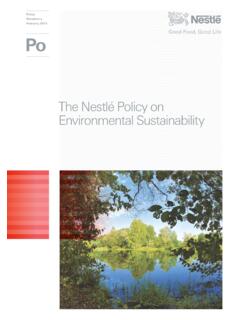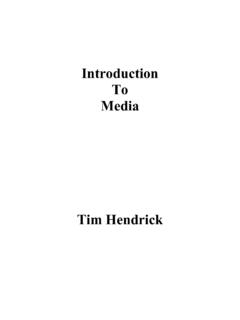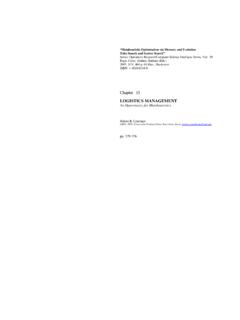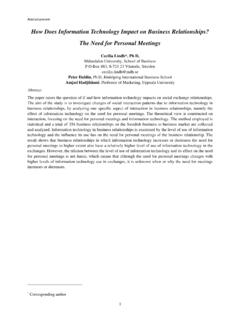Transcription of FOOD AND AGRICULTURE ORGANIZATION WORLD HEALTH …
1 FOOD AND AGRICULTURE ORGANIZATION WORLD HEALTH ORGANIZATIONOF THE UNITED NATIONSASSURING FOOD SAFETYAND QUALITY:GUIDELINES FOR STRENGTHENING NATIONALFOOD CONTROL SYSTEMSJ oint FAO/WHO PublicationPage iiiTABLE OF FOOD Food Safety, Quality and Consumer Global Considerations4(a) International Trade4(b) Codex Alimentarius Commission4(c) SPS and TBT OF A NATIONAL FOOD CONTROL Building Blocks6(a) Food Law and Regulations6(b) Food Control Management7(c) Inspection Services7(d) Laboratory Services: Food Monitoring and Epidemiological Data8(e) Information, Education, communication and NATIONAL FOOD CONTROL Principles of Food Control: Issues for Consideration10(a) integrated farm-to-table concept10(b) Risk Analysis11(c) Transparency11(d) Regulatory Impact Developing a National Food Control Strategy12(a) Collection of Information12(b) Development of Strengthening Organizational Structures for National Food ControlSystems13(a) Multiple Agency System13(b) Single Agency System15(c) integrated Funding National Food Control ISSUES OF DEVELOPING Food Food Processing Street Food Control Infrastructure and Technical Assistance.
2 Role of International Agencies20 Page ivANNEX and Key Contacts23 ANNEX of Food Safety and Consumer Protection25 ANNEX the Joint FAO/WHO Codex AlimentariusCommission29 ANNEX the WTO SPS and TBT Agreements36 ANNEX for Developing a National Food Law54 ANNEX JECFA, JMPR, JEMRA, and GM Food RiskAssessment58 ANNEX Country Profile Collection of Information63 ANNEX Studies National Food Control Systems65 ANNEX 10. Selected Organizational Components of a National FoodControl Agency70 ANNEX 11. Possible Activities to be Undertaken during the Establishmentof a National Food Control Agency73 Page national food control systems are essential to protect the HEALTH and safety ofdomestic consumers. They are also critical in enabling countries to assure the safety and qualityof their foods entering international trade and to ensure that imported foods conform to nationalrequirements.
3 The new global environment for food trade places considerable obligations on bothimporting and exporting countries to strengthen their food control systems and to implement andenforce risk-based food control are taking unprecedented interest in the way food is produced, processed andmarketed, and are increasingly calling for their Governments to accept greater responsibility forfood safety and consumer Food and AGRICULTURE ORGANIZATION of the United Nations (FAO) and the WORLD HealthOrganization (WHO) have a strong interest in promoting national food control systems that arebased upon scientific principles and guidelines, and which address all sectors of the food is particularly important for developing countries as they seek to achieve improved foodsafety, quality and nutrition, but will require a high level of political and policy many countries, effective food control is undermined by the existence of fragmentedlegislation, multiple jurisdictions, and weaknesses in surveillance, monitoring and guidelines seek to provide advice to national authorities on strategies to strengthen foodcontrol systems to protect public HEALTH , prevent fraud and deception, avoid food adulteration andfacilitate trade.
4 They will enable authorities to choose the most suitable options for their foodcontrol systems in terms of legislation, infrastructure and enforcement mechanisms. Thedocument delineates the overarching principles of food control systems, and provides examples ofpossible infrastructures and approaches for national target users of these Guidelines are national authorities concerned with ensuring foodsafety and quality in the interests of public HEALTH and consumer protection. The Guidelines willalso be of assistance to a range of other stakeholders including consumer groups, industry andtrade organizations, farmer groups and any other groups or associations that influence nationalpolicy in this publication Assuring Food Safety and Quality: Guidelines for StrengtheningNational Food Control Systems was prepared to enable national authorities, particularly indeveloping countries, to improve their food control Guidelines replace the earlier FAO/WHO publication Guidelines for Developing anEffective National Food Control System (1976) - FAO Food Control Series No.
5 1; WHO FoodControl No. 1. For over 25 years this publication has been the definitive reference for developingcountries in planning, organizing, and implementing their national food control has changed in the intervening period. There have been advances in the control offoodborne hazards as well as improvements in food inspection and surveillance of the food supply chain, the increasing importance of the Codex AlimentariusCommission, and the obligations emerging from the WORLD Trade ORGANIZATION (WTO)Agreements have resulted in unprecedented interest in the development of food standards andregulations, and the strengthening of food control infrastructure at the country challenges for food control authorities include: Increasing burden of foodborne illness and new and emerging foodborne hazards; Rapidly changing technologies in food production, processing and marketing; Developing science-based food control systems with a focus on consumer protection.
6 International food trade and need for harmonization of food safety and quality standards; Changes in lifestyles, including rapid urbanization; and Growing consumer awareness of food safety and quality issues and increasing demand forbetter , the incidence of foodborne diseases is increasing and international food trade isdisrupted by frequent disputes over food safety and quality requirements. Many food controlsystems need to be revised and strengthened if improvements are to be realized. It has neverbeen more important for developing countries to implement and enforce a food control systembased on the modern concept of risk assessment. These Guidelines provide importantinformation on the principles and practices of food control and the trend away from a merelypunitive to a preventive approach to food for food control in most countries is shared between different agencies orministries.
7 The roles and responsibilities of these agencies may be quite different andduplication of regulatory activity, fragmented surveillance and a lack of coordination arecommon. There may also be wide variations in expertise and resources between the differentagencies, and the responsibility for protecting public HEALTH may conflict with obligations tofacilitate trade or develop an industry or Guidelines provide information for government agencies to assist in the developmentof national food control systems and to promote effective collaboration between all sectorsinvolved in the management and control of food safety and quality. They highlight the importanceof developing effective relationships and mutual support among government agencies andinstitutions involved in food control and other stakeholders, particularly the food industry andconsumer FOOD Safety, Quality and Consumer ProtectionThe terms food safety and food quality can sometimes be confusing.
8 Food safety refers toall those hazards, whether chronic or acute, that may make food injurious to the HEALTH of theconsumer. It is not negotiable. Quality includes all other attributes that influence a product s valueto the consumer. This includes negative attributes such as spoilage, contamination with filth,discoloration, off-odours and positive attributes such as the origin, colour, flavour, texture andprocessing method of the food. This distinction between safety and quality has implications forpublic policy and influences the nature and content of the food control system most suited to meetpredetermined national control is defined as:..a mandatory regulatory activity of enforcement by national or local authorities toprovide consumer protection and ensure that all foods during production, handling,storage, processing, and distribution are safe, wholesome and fit for humanconsumption; conform to safety and quality requirements; and are honestly andaccurately labelled as prescribed by foremost responsibility of food control is to enforce the food law(s) protecting theconsumer against unsafe, impure and fraudulently presented food by prohibiting the sale of foodnot of the nature, substance or quality demanded by the in the safety and integrity of the food supply is an important requirement forconsumers.
9 Foodborne disease outbreaks involving agents such as Escherichia coli, Salmonellaand chemical contaminants highlight problems with food safety and increase public anxiety thatmodern farming systems, food processing and marketing do not provide adequate safeguards forpublic HEALTH . Factors which contribute to potential hazards in foods include improper agriculturalpractices; poor hygiene at all stages of the food chain; lack of preventive controls in foodprocessing and preparation operations; misuse of chemicals; contaminated raw materials,ingredients and water; inadequate or improper storage, concerns about food hazards have usually focused on: Microbiological hazards; Pesticide residues; Misuse of food additives; Chemical contaminants, including biological toxins; and list has been further extended to cover genetically modified organisms, allergens,veterinary drugs residues and growth promoting hormones used in the production of animalproducts.
10 For more details see Annex expect protection from hazards occurring along the entire food chain, fromprimary producer through consumer (often described as the farm-to-table continuum). Protectionwill only occur if all sectors in the chain operate in an integrated way, and food control systemsaddress all stages of this no mandatory activity of this nature can achieve its objectives fully without thecooperation and active participation of all stakeholders farmers, industry, and consumers, thetermFood Control System is used in these Guidelines to describe the integration of a mandatoryregulatory approach with preventive and educational strategies that protect the whole food an ideal food control system should include effective enforcement of mandatoryrequirements, along with training and education, community outreach programmes and promotionPage 4of voluntary compliance.















